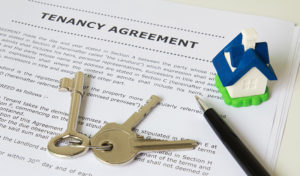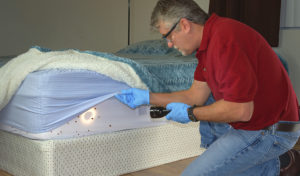Pest control in a rental property can be a serious issue. But, whose responsibility is it to take care of a pest problem in a rented unit or home — the tenant or the landlord?
What to Do About Pest Control in Rental Property
Pests are one of the biggest problems property owners face today. It is very difficult to get rid of pests, especially once you have a full-blown infestation on your hands. But, in the case of rental properties, who bears the responsibility of answering for pest control?
When it comes to pest problems, and just tenant problems in general, both tenants and landlords can experience frustrations. For tenants, unresponsive landlords are a huge source of pain. When landlords fail to reply or act on reported issues, it can drive tenants crazy with annoyance. For landlords, neglectful tenants or those who always seem to find something to complain about are aggravating.
But, who is responsible for pest control in a rental property to begin with? The first place you should refer to, whether as a landlord or tenant, is state and local laws. While many states do not make the answer explicitly clear, they also have statutes that require landlords to keep rentals in livable condition.
The Rule: When the Landlord Is Responsible
 Are landlords responsible for pest control? Generally, pest control falls under the responsibility of the landlord since it is usually part of property maintenance.
Are landlords responsible for pest control? Generally, pest control falls under the responsibility of the landlord since it is usually part of property maintenance.
Landlords also have an unwritten obligation to keep their rental in habitable condition, and pests can definitely make a home uninhabitable. With this in mind, pest control does tend to be the landlord’s responsibility, with some exceptions (discussed in the next section).
Pests can invade a home without warning. It is also typically the landlord’s responsibility to perform pest control duties not only as a part of general property maintenance but also as seasonal maintenance. Moreover, if the pest is natural or common to the area, pest control duties fall on the shoulders of the landlord.
Landlords should also make sure to inspect the property for any pests in between tenants. You must see to it that the rental is free from any pests before a new tenant moves in. Performing a move-in inspection with the tenant, along with documentation, is paramount. This way, the tenant can acknowledge that the property is pest-free at the time of move-in.
Keep in mind that neglect can also indirectly give rise to pests in the rental unit. If there are any cracks, gaps, or openings left unaddressed, pests can use these as entry points. In general, unless these openings are due to the tenant’s fault, it is the landlord’s duty to remedy them.
The Exception: When the Tenant Is Responsible
Although it is generally the landlord’s responsibility to take care of pest control, a given circumstance can transfer the obligation to the tenant. This is when the pest infestation is the result of the tenant’s actions or neglect.
Let’s face it — some tenants can be too carefree. They leave food everywhere, wait days to clean out their sink, and improperly dispose of their trash. Such living behaviors can certainly invite all kinds of pests into the home. In this case, where the tenant is at fault, the tenant must bear the responsibility of pest control.
To avoid any opportunities for misunderstandings, you should include a pest control clause in the rental agreement that says the tenant should answer for pest control if it is their fault that pests invaded the home. Such a clause, though, will usually require you to prove that the infestation was, in fact, the tenant’s fault. You can do this by documenting the tenant’s unhealthy living behaviors and conditions that can lead to pests.
How Pest Types Play a Role
The rule of thumb when it comes to pest control in rental property units is that it is the landlord’s obligation. But, the type of pests can play a role in who answers for this service, too. For instance, as previously explained, it is generally the landlord’s responsibility if the pest is common or natural to the area.
1. Termites
For termite infestations, the responsibility also rests in the hands of the landlord. This is because termites can deal damage to the structure and foundation of the building. Thus, it can compromise the safety of everyone inside. Ensuring your rental property is up to safety codes is part of your obligations as a landlord.
2. Fleas
As for fleas, it is not always the landlord’s responsibility. More often than not, fleas find their way into the rental property because of pets. Therefore, if the tenant’s pet brought the fleas home, the tenant should pay for the treatments.
3. Bed Bugs
 Bed bugs have become a hot issue in many states because of rising infestation rates.
Bed bugs have become a hot issue in many states because of rising infestation rates.
In fact, it is such a subject that often invites debate, so much so that some states (like New Hampshire) have passed pest control apartment laws relating to bed bugs and whose responsibility it is to get rid of them.
When it comes to these bloodsuckers, though, the general rule follows. If the property was free of bed bugs when the tenant first moved in, then you can conclude that the tenant brought them into the home. Therefore, the tenant should be responsible. But, if the property has had a past issue with bed bugs, then the landlord should be responsible.
Reporting Pest Issues to Landlords
Pests are one of those problems that can quickly snowball out of control. Once you have an infestation, it becomes harder, not to mention more expensive, to get rid of them. As such, it is important to inspect the property and take action at the first sign of a pest problem.
Tenants must immediately report the issue to their landlord for remedy. As a landlord, you may feel tempted to first decide who is at fault. After all, pest control costs money.
However, it is imperative that you fix the problem before doing anything else, as pest issues can deal serious damage to your property and can be hazardous to the health of the occupant/s. They can also significantly impact property values. Therefore, you must act fast and get rid of the pests first. Then, later on, you can decide who is responsible.
When tenants encounter pests in rental property, their usual first instinct is to contact their landlord to report the issue. But, what if their landlord is unresponsive or ignores the complaint? Depending on state laws, if the tenant provides a written notice of the issue and the landlord fails to respond, they may be able to withhold rent.
As a landlord, you have a lot more to lose when pests invade your rental property. As such, make sure to pay attention to the requests of your tenant and address them as quickly as you can, especially if they are pest-related concerns.
To Sum It Up: Who Is Responsible for Pest Control When Renting?
Pest control in rental property is generally the responsibility of the landlord, except in cases wherein the tenant is at fault for the infestation. Since pests can bring great damage and stress, though, it is best to get rid of them first when a tenant reports the problem and simply discuss who should pay for the cost later on.
Pest control is just one of the many hardships involved in rental property management. Make your life as a landlord easier by hiring a property management company to help. Look for the best one in your area today using our online directory.
RELATED ARTICLES:
- Removing Mold In Apartment: Is It Tenant Or Landlord Responsibility?
- The Ins And Outs Of Rental Property Maintenance and Repairs
- Is Landlord Responsible For Fallen Tree?




 Company
Company